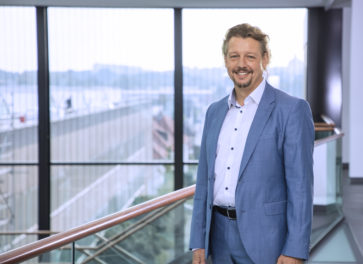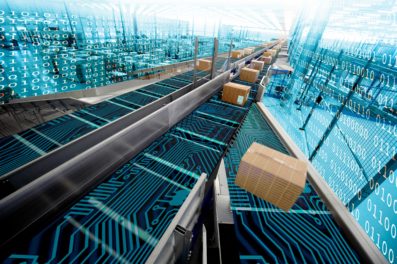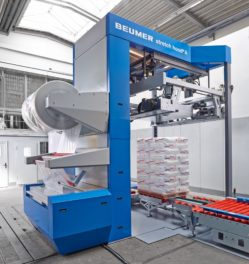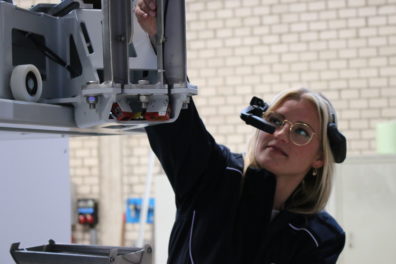Bodo Schlenker, Divisional Director Software Solutions at BEUMER Group:
Bodo Schlenker has been Divisional Director Software Solutions at BEUMER Group since April 2021. As such, the computer scientist will strategically align the Software Solutions division with the ever-growing market requirements in terms of digital offers to create added value through smart software solutions with the highest quality standards, innovation drive and a sense of sustainability. In this interview, he describes what drives the industry and where the journey is headed.
Mr. Schlenker, what role does the topic of Software Solutions play in BEUMER Group?
Bodo Schlenker: In the Software Solutions division, our digital offerings strategically target the continuously increasing market requirements to be in a position to offer our customers substantial added value through smart software solutions. Our aim is to achieve the best possible results in optimising customer processes, for example in e-commerce, in the CEP sector, in conveying technology or in baggage sortation at airports. Data analytics are playing an increasingly important role to generate information in real time: “What does the process look like?”, “What is the system state?” or “What is the system utilisation level?”. The demand for software solutions in intralogistics is huge and it will continue to increase in the years to come.
How important is software to customers?
Bodo Schlenker: When it comes to supporting our customers, software is a very clear differentiating factor. They don’t just want to buy a machine; they want a solution for their problem and it’s precisely this solution that we look to provide. What does that mean for us? We can connect and network the physical world with the digital world through smart software solutions, connectivity, and data analytics, and to ensure end-to-end material and data tracking. The closer we are to the customer process, the better we can support users.
How can you support customers with Data Analytics and where do you see challenges?
Bodo Schlenker: Data analytics can be understood as an offer to visualise information relating to their operating processes for customers on site via control stations, to be preventive or even predictive. This is where the Human Machine Interface really comes into its own. The systems we supply to our customers are relevant to processes in customer production and need to be highly available. This means that the machines need to be able to ‘talk’ to their environment. Of course, given the wide variety of machines, this is a serious challenge and requires the machines to be ‘intelligent’. This is the only way to ensure that can data be generated, stored, and evaluated in a targeted manner. What this means for us, is that it is important to shift more and more work to the network. After all, our machines do not always produce and work on their own, that is, as stand-alone solutions for our customers. Our machines are integrated or combined with other systems from OEM suppliers. It is always important to understand how the customer’s end-to-end process works. Thanks to smart software and data analytics, we can map and connect the entire customer process across different system structures and vendors. It’s always about the big picture. Equipping new machines with the intelligence they need is quite simple. Systems that are already in use at customers need to be prepared for upgrades step by step.
But how do you know what the market needs?
Bodo Schlenker: Customers are a very important source for us. Of course, they will tend to only tell us about the topics that they themselves consider relevant. Topics that are not “on their radar” because they are not currently an issue for them – also known as unarticulated needs – are something they don’t discuss with us. These are typically longer-term trends that can play out in the market as well as on the engineering side. In order to identify these, I liaise with institutes and service providers for trend analysis and innovation, for example, who are very into trend developments and ideas for the future. With their help, we can look five to ten years into the future. Gazing into this crystal ball is really exciting. We interpret this long-term trend screening and convert it into a medium-term tactical roadmap. That means we first assume a time horizon of ten years, then five to three years, and finally one year. This process is always iterative. We regularly review and reflect on trend developments on an annual basis. This enables us to develop new solutions that the market demands.
Can you describe your outlook on the next five to ten years?
Bodo Schlenker: It’s very exciting. Just consider the field of logistics globally. It raises the question of limits. ‘Ordered today, delivered tomorrow’ is already the standard. Personally, I don’t think that even faster speeds will be needed in the coming years, but instead improvements in performance and supply chain resilience across the board. I also expect to see stronger consolidation of material flows in the ‘last mile’. The status quo is like this: DHL rings your doorbell at 10 a.m., Hermes arrives at 1 p.m. and Amazon a few hours later, even though you placed all three orders with, say, Amazon. There is a huge amount of potential here if all of this could be merged. On top of this, another thing is worthy of note: returns processing. This can account for up to 60 percent of material flows in some distribution centres, for example in the fashion sector. Also, imagine that when the yellow recycling bag is picked up at your door, that the package with the returns for your retailer is picked up at the same time. That consolidates the material flow right at the front door.
Another development I see is in luggage tracking. For example, you check in your luggage at the airport at the beginning of your trip and simply pick it up at your destination. Even if you change planes or take the train as part of your trip, you don’t have to worry about anything – regardless of the airport, the airline you’re flying with, or the train station.
That takes to the buzzword urbanisation: we are seeing a clear trend towards a continually growing proportion of mankind living in the world’s major centres. This is perhaps a little different in Germany but look at the megacities. In this context, logistics will become a major challenge. Presumably, many small local, and possibly even mobile, distribution centres will shoot up more or less just around the corner. These centres are part of the answer to the challenges that arise with relation to the last mile. These are then trends and developments that I see coming in the next five to ten years. And they can only be managed with a good data structure, state-of-the-art algorithms, a smart user experience and interfaces, flexible IT architectures, machine learning and AI. BEUMER Group will be offering software solutions across this entire spectrum.
Do you have the expertise you need internally?
Bodo Schlenker: We certainly do, and we are fundamentally capable of solving all of these issues. What’s exciting about IT is that no other field develops so quickly that you could mistakenly believe that you have every skill set and always will have. It’s a matter of constantly evolving and networking. We look very carefully at what tools we work with, and this always keeps us at the cutting edge of technology. Thus, we also ‘partner’, which means we work closely with research institutes, the Fraunhofer Institute, for example.
Do customers recognise the benefits and are they willing to invest in software?
Bodo Schlenker: Of course, any purchase initially means capital outlay. The question that arises is “What value can I add with software?” In my own experience, the factor of cost savings between a physical-only solution and one with integrated intelligence can be exponential. For example, a smart algorithm means that you can optimise package sorting. Without the software, you would always have to change the hardware and consequently the complete mechanical setup to bring the system in line with the new requirements. And that can end up being significantly more expensive. The differences our customers can make with software are significant. Put simply, they are investing in a smarter and more sustainable way.
What does customer demand look like?
Bodo Schlenker: Demand is high, and the outlook for the coming years is even stronger. We are only just starting to talk to our customers about software. Imagine a door that we have just opened slightly and a whole bunch of people are pushing their hands into the gap. We can’t close it again. That’s how strong the demand is. However, we need to be able to meet customer demand while at the same time retaining the ability to deliver on a sustainable basis. That is what we have to focus on now. The trend is clearly visible wherever you look. The customers come from every industry. The potential is massive and exponential.
What does BEUMER Group’s strategy for being able to implement all of this look like?
Bodo Schlenker: We need to actively shape this process of change. That is why we agreed at a very early stage to define and implement a holistic software strategy in collaboration with management. The question we asked ourselves was what our basic tasks are as a software solutions organisation in BEUMER Group. What aims do we want to achieve, how do we describe our visionary image, and how do we get there?
On top of this, we have also defined our strategic aims and, naturally, what our go-to-market strategy on the subject of software and IT should look like. In order to achieve it, we need the right products and matching process integration within the organisation. The right team is certainly also decisive. We need to be able to deliver, implement and develop software globally. If we are with a customer and they tell us they need a system, we have to understand their process and be in a position to deliver the software. Of course, it’s also important to bring in specialists. Software developers are sought after wherever you look now, so it’s essential for us to be noticed as an attractive employer in terms of technology and software. We want people to have a genuine desire to join BEUMER Group. What is also important is how our solutions are perceived by the users. We are focusing on the touch-and-feel, very much like the approach Apple takes, for example. What this means is that users give us direct feedback on how they experience our solutions in terms of handling and the application. We refer to this as the user experience and it’s how we learn. To facilitate this feedback, we have to be in close contact with our customers. This learning process and many other things create the foundation for us to derive a strategic roadmap with a total of 100 activities.
What sets BEUMER Group apart from other companies?
Bodo Schlenker: Nobody can ignore the topic of digitalisation today. At BEUMER Group, I was impressed from the outset by digitalisation being firmly anchored in the corporate strategy. There is a clear commitment to digitalisation here and to software solutions in the extended design process. You cannot take this for granted in companies with a history in mechanical engineering. Digital transformation is not something that will just happen to BEUMER Group; instead, it will make the difference in how we shape our business activities in the future. This forward-looking approach is a special characteristic of BEUMER Group. Our motto is “Long-term success instead of short-term gain”. If we as an organisation have the necessary calm and disciplined mindset, we can invest in the future. And that is what characterises us and sets us apart.

















